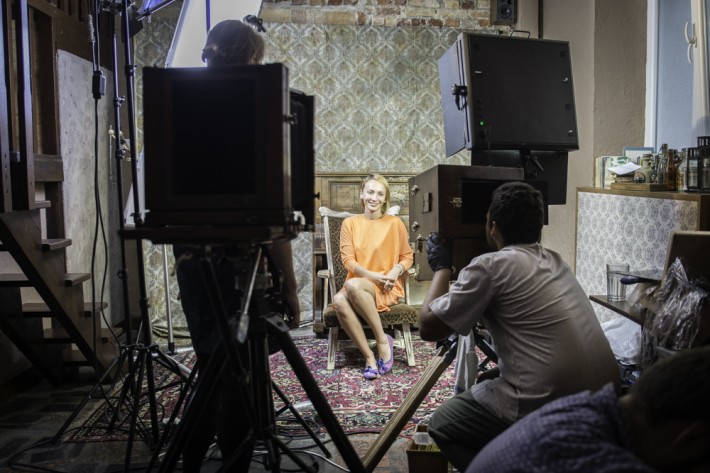Polish photographer Emil Stankiewicz’s has created a unique, handmade Talbotype camera nicknamed Idlozi, which means “window to your heritage soul.” Each unique image captured by the wooden camera starts as a paper negative which is then rephotographed with the same box camera to yield a positive print. The camera also known as a “street camera” or “á la minute camera” are inspired by Henry Fox Talbot’s calotype, the British inventor who was able to create a paper negative from which positive prints could be contact printed.
“I was inspired by Jakub Smolski, the village photographer from Luka,” said Stankiewicz. “He was taking photos about 1930 to 1945 with hand made camera with darkroom inside and reproduction arm. He was photographing rural residents and villages life. I was inspired by the camera and photos.”

Emil was drawn to the Talbotype process after progressing through a common photographic sequence using digital. Shooting macro subjects led to sports and action photography of BMX cyclists and skateboarding using radio-controlled flashes. He was drawn to this alternative process, as it felt more intuitive — using negative paper with low sensitivity, sunlight as the light source and one lens. The camera took a year to build and was in a state of constant modification based on field-testing.


“The main challenge with the camera is time,” said Stankiewicz. “People want ‘fast photos’ like digital or polaroid. My camera needs a few minutes to make negatives and then a positive. People really do like the final images.”


Stankiewicz’s process differs from the original Talbotype in that he rephotographs the negative to create the positive while Talbot’s process involved contact printing the negative using salted paper. “I use FOMA papers and difference chemist,” he said. “I make positives on reproduce arm by photographing the negatives.”

The portrait work continues but Emil is now leading workshops with schools back home in Bialystok, Poland through a program called "PROJEKTOR - wolontariat studencki" (PROJEKTOR - student's volunteer). His students are learning about the history of photography and a process that was used locally to capture portraits of villagers and their daily life.
All images appear courtesy of Emil Stankiewicz and Tomasz Pienicki. You can follow Emil and his camera via his Facebook page.






Although I really enjoy this post and appreciate the efforts the artist has gone into create such work....I always ask myself the question when I read articles on creative types revisiting old styles of masters, using older equipment or recreating it etc.... why? The images just look older and dated to me, but again why?.. With so much technological to create an stunning image today be it digital or a great film camera,what is the purpose other than to replicate something we had in my grandmothers day?
I respectfully just don't get it.
Same reason people restore old cars, or learn to use a manual lath or milling machine. Same reason Jesse James learned and still learns how to manipulate metal by hand or people learn to paint on canvas. Art comes in many forms and while technology makes it easier to make things it is good to know the process and history before it is gone. People that want to learn and discover these lost arts much like explorers want to climb mountains. Everyone has their Everest, I am sure you do something long winded and inane that others find bothersome or long in the tooth.
Great reply Spider-Man, I do agree with much of your response.
That's the greatest thing about this site and many others around, terrific posts, great information, sharing of ideas and techniques......and at times disagreement on some of the articles posted. Non the less the first site I jump to daily after checking my email
Good thoughts here and appreciate your support Paul. Ernest Hemingway once said that "it was incumbent upon the writer to know as much about life as possible." I take that to mean to adequately master his craft, he felt it important to be able to pull from a wellspring of knowledge, both book and experiential. The more skills in the medium of image-making that you can leverage creatively, the greater range of possibilities at your disposal. We can make images now with a tonal range, colors and sharpness but the accidents are lost, the serendipity of the unexpected that comes with chemicals and antique cameras. I enjoy seeing what people are doing in looking backward and keeping these processes alive. Without them, things would be sharp, high resolution, saturated…. and, at times, all too perfect.
A point well presented Joseph. Yet another terrific article for FStoppers, and just another reason why this site gets mine and so many other creatives attention. I tip my hat to you.